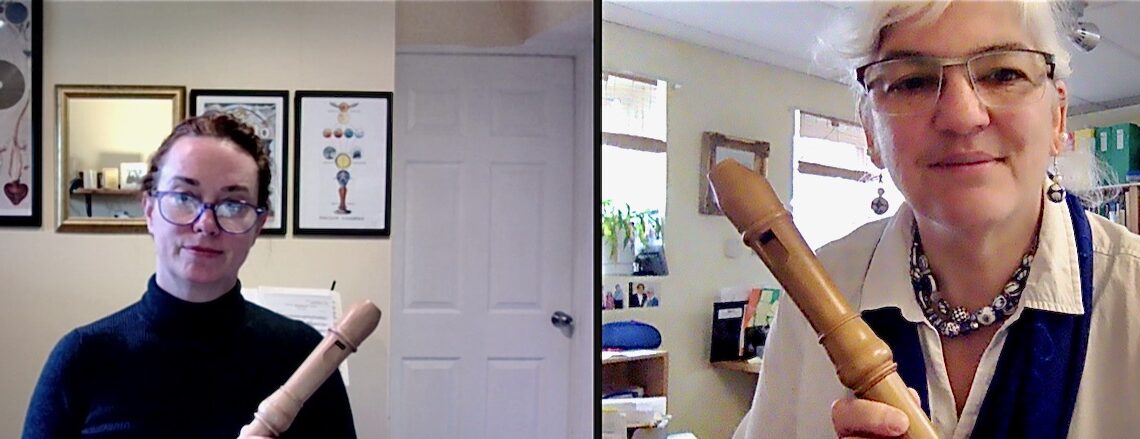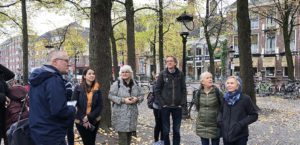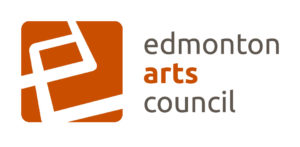Matsumoto, October 2023
Playing my recorder
at the feet of Suzuki sensei,
outside the Talent Education
Research Institute building
in Matsumoto.
See this article as printed in the January 2024 International Suzuki Association Journal here: https://internationalsuzuki.org/journal/ISA-Journal-20-2.pdf
Ever since I started Suzuki Teacher training (over 20 years ago!), I kept hearing about the Talent Education Research Institute in Matsumoto, the school founded by Shinichi Suzuki. Everyone who had been there said it was a wonderful experience it was to go there and study with Suzuki sensei and the other Japanese master teachers, at a school that was completely immersed in the implementation of his philosophy. So I was very excited when the the opportunity came to attend the International Suzuki Teacher Trainers Conference in Matsumoto!
The first thing I did after arriving in Matsumoto, was to make a pilgrimage to the Shinichi Suzuki Memorial Hall, his former house which is now a museum. I sat in the room where he taught his students, and in his office where he listened to all of the graduation recordings, and thought about the origins of the Suzuki movement. Suzuki’s goal was not to train professional musicians, but to develop character through the study of music. Developing the skill of self-expression by playing a musical instrument developed other other fine personal qualities that Suzuki termed a “noble spirit”. The approach that he developed to foster this goal also enables students to develop very high level of ability at a young age. Sometimes, the striving for this high level of playing becomes the primary focus, and overshadows the original goal of character development.
So now I was ready to attend the conference. The main topics of discussion were:
- International equivalency of training credentials
- The importance of the beginning stages for a young student
- Graduation protocols
The graduation discussions were the most inspiring. We had the opportunity to hear Suzuki’s own recorded comments from former students’s graduation recordings, which are archived at the Talent Education Research Institute. All his comments to the students were about the nobility of character, kindness, respect, and love that he could perceive through their playing. Any technical issues about any student’s playing were addressed to their teacher, not to the student. There was also discussion about how graduation recordings and events were handled by different Suzuki organizations around the world. So many different ways to inspire and encourage students to set goals and celebrate success! I came home inspired to revise my own studio and program graduation to meet the needs of the students in my community in a more flexible manner.
The discussions about the foundations of the Suzuki philosophy, especially in starting students at the youngest possible age, were not as clearly focussed as the graduation discussion. I learned that the implementation of the Suzuki Early Childhood Education program was not as uniform between countries as the approach to instrumental instruction. Interesting questions came up regarding the cultural relevance of the curriculum, and age-appropriate activities for both early childhood and early instrument instruction. What impressed me about these discussions was how everyone wanted to know more about what everyone else was doing, so they could have more resources to do what is best for the children. I returned home with a sheaf of new resource material and many creative ideas for implementation. I think that as long as the teachers keep the needs of the children first, and keep the foundational tenets of the Suzuki philosophy in their work, variations in approach can only enrich our global community.
When it came to discussing the potential creation of an internationally accepted standard of teacher training, that is when I learned the importance of good communication. There were lots of good intentions, but not everyone had the same experience or information. Presentations were made about the training programs in different regions before the discussions began, but each region presented slightly different information, so the people who did not have direct experience with working in different regions (European Suzuki Association (ESA), Suzuki Association of the Americas (SAA), Pan Pacific Suzuki Association (PPSA), etc …) were still unclear on the differences in training programs between regions. So most of the discussions I participated in were filling in gaps in knowledge, rather than actually comparing systems and looking for differences and commonalities. There was a resolution passed at the conference to make sure that the lines of communication would be more open on this issue, especially for teachers who move between regions, so everyone knows what training will be accepted and what training will have to be added in the system that they are moving into.
I realized, as people were exchanging information and filling in the blanks for each other, that most of the training systems cover the same material, just packaged into different course formats. The big difference is in the entry requirements for the teachers. It ranged from needing a music degree and an audition of upper level material to begin (ESA) to taking the course with no prerequisite, but playing an exit exam to show understanding of the material (SAA – Latin America). So I wonder to myself, what is the best way of helping teachers realize the benefits of implementing the Suzuki philosophy in their teaching, so that the maximum number of students can have the opportunity to develop their character and their musical ability? This is the question I took back to my fellow Suzuki Recorder teacher trainers. Our group of ESA and SAA registered teacher trainers are looking at ways we could potentially use the flexibility of our smaller community to merge training systems.
As a flute, recorder, and Suzuki Early Childhood teacher, I appreciate being part of a smaller community. Most of the teachers and trainers know each other, and I have witnessed many innovative and flexible collaborations and solutions in small classes at Institutes and Conferences. But at the end of the conference, when you find yourself in a small room in the basement with the guitar, double bass, harp, and trumpet people, you wonder if there is a way to make the instruments with smaller student and teacher populations feel that their ideas are valued as much as the violins, cellos, and pianos.
The recorder teachers performed for the Talent Education Research Institute event that followed the conference, to demonstrate an instrument that was not part of the TERI offerings. Some of the European teachers who were there asked why there were not more recorder teachers and students? But the ESA presentation during the teacher trainer discussions stated that they were aiming for quality over quantity. So this took me back to my thoughts when I was sitting in Suzuki sensei’s living room, now a museum honouring his humanitarian goal of developing noble hearts through music. If all of us in the Suzuki community are all striving to develop noble hearts, do we need to segregate ourselves into geographic or instrument specific groups? Is there a way that we can promote and strengthen our mutual commitment to the Suzuki philosophy, and still be flexible to accommodate the variety of needs that are unique to the instruments we play and the countries where we work? I do not have an answer to this question, but I do know that continuing the conversation, both on-line and in person at more international conferences will lead to more collaboration. I am hoping to be at the next one and be part of this work.





